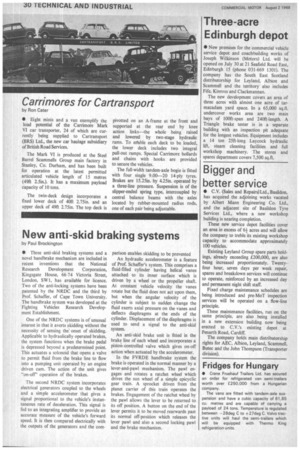New anti-skid braking systems
Page 32

If you've noticed an error in this article please click here to report it so we can fix it.
by Paul Brockington • Three anti-skid braking systems and a novel handbrake mechanism are included in recent inventions that the National Research Development Corporation, Kingsgate House, 66-74 Victoria Street, London, SW!, has available for licence. Two of the anti-locking systems have been patented by the NRDC and the third by Prof. Schaffer, of Cape Town University. The handbrake system was developed at the Fighting Vehicles Research Development Establishment.
One of the NRDC systems is of unusual interest in that it averts skidding without the necessity of sensing the onset of skidding. Applicable to hydraulically operated brakes, the system functions when the brake pedal is depressed beyond a predetermined point. This actuates a solonoid that opens a valve to permit fluid from the brake line to flow into a pumping unit operated by an engine driven cam. The action of the unit gives "on-off" operation of the brakes.
The second NRDC system incorporates electrical generators coupled to the wheels and a simple accelerometer that gives a signal proportional to the vehicle's instantaneous rate of deceleration. This signal is fed to an integrating amplifier to provide an accurate measure of the vehicle's forward speed. It is then compared electrically with the outputs of the generators and the com
parison enables skidding to be prevented An hydraulic accelerometer is a feature of Prof. Schaffer's system. This comprises a fluid-filled cylinder having helical vanes attached to its inner surface which is driven by a wheel or the propeller shaft. At constant vehicle velocity the vanes rotate but the fluid does not act upon them, but when the angular velocity of the cylinder is subject to sudden change the fluid exerts axial pressure on the vanes and deflects diaphragms at the ends of the cylinder. Displacement of the diaphragms is used to send a signal to the anti-skid system.
An anti-skid brake unit is fitted in the brake line of each wheel and incorporates a piston-controlled valve which gives on-off action when actuated by the accelerometer.
In the FVRDE handbrake system the brake is operated in the normal manner by a lever-and-pawl mechanism. The pawl engages and rotates a ratchet wheel which drives the sun wheel of a simple epicyclic gear train. A sprocket driven from the planet carrier of this train operates the brakes. Engagement of the ratchet wheel by the pawl allows the lever to be returned to its off position. A button on the end of the lever permits it to be moved rearwards past its normal off-position which releases the lever pawl and also a second locking pawl and the brake mechanism.




































































































